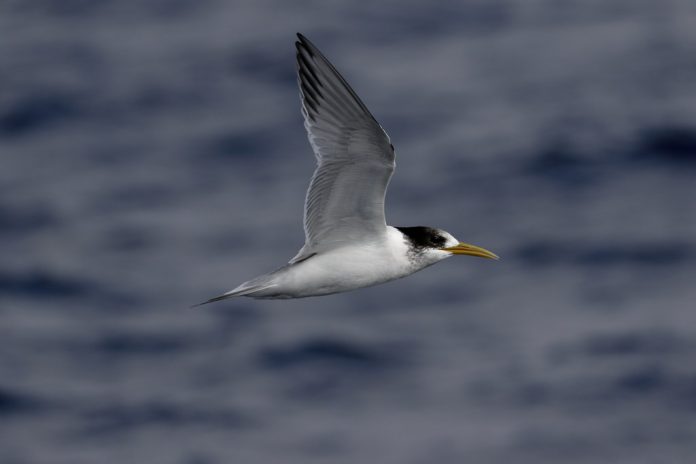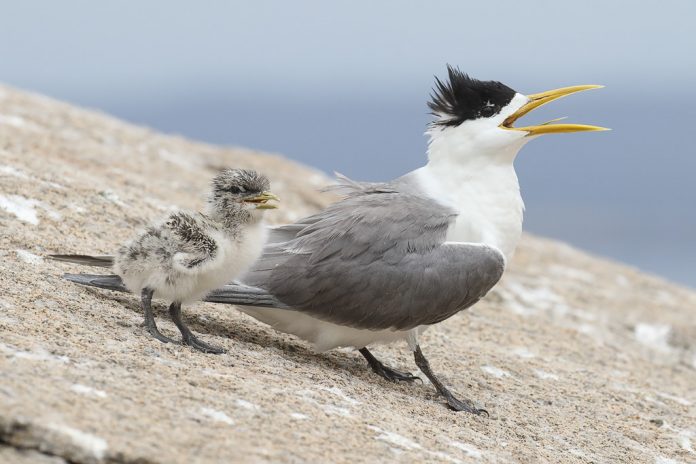Crested tern is the second largest of Australia’s terms, and it is also one of the most familiar and abundant, frequenting shores and inshore seas around the entire coastline. In ones and twos to flocks of 40-50 or more, it rests on sand spits, low points, and reefs along coastal beaches and inlets and fishes the seas and estuaries close by; hardly ever does it range far out from the shore into blue water or inland along with bodies of fresh water.
The crested tern can swim and float for hours on the water and often bathe there then swim to a beach to dry off and preen. At night they fly to gather in large groups in isolated spits and offshore islands to roost on the ground. On slender rakish wings, Crested Terns fly gracefully with sweeping leisurely beats.
They sometimes play with small shells and pebbles in flight. When fishing they quarter the seas from 5-15 meters up, bills pointing down, watching. Sighting prey, they plunge headlong onto it, hitting the water with a splash and submerging momentarily before flying off Small surface fish 5-8 centimeters long are eaten almost exclusively, grabbed behind the head, although eggs and baby turtles are sometimes taken.
Indeed, fishermen have regularly used flocks of feeding terns to help guide them to shoaling pilchards. Crested Terns gather in colonies of up to several thousand to breed on offshore islands right around the coast. The colonies are in a constant state of flux, varying in their sites, times, and numbers from year to year.
In display, a bird walks to its mate carrying a fish, crest erect, wings trailing. Its mate parades around it, then both fly up, one behind the other, in a zigzag spiraling flight too often 200 meters before gliding back to earth, twisting and turning. The nests are spaced about one meter apart, just beyond the pecking distance.
One or other parent broods the young in their first few days until they are old and strong enough to join crèches. After fledging, young disperse far from their parental colonies, some having been recorded traveling halfway around the continent, south to east. It is also known as Greater Crested Tern, and Swift Tern is a tern in the family Laridae.
The size of the crested tern is approximately 445-485 mm in length. Thus, both sexes are similar. Inbreeding plumage, crown black to eyes, the feathers elongated in erectile crest over nape; forehead broadly white. Therefore, the upper parts are wings and a shallowly forked tail mid-grey. All underparts are white. The eyes are dark brown the bill is mid-yellow, at times faintly orange. The feet are black. In nonbreeding plumage black crown streaked white; bill lemon-yellow.
The immature is as non-breeding adults; upperparts freckled dusky and white in first three months, later washed blotchy dusky and white on shoulders; flight feathers and squarer tail duskier grey; bill dirty lemon. The downy young are sandy and freckled dusky. The crested tern flock calls aloud, rasped kirrik; wep-wep in alarm; cawing in courtship and display; peevish whistles from juveniles.
Their habitats of nesting and breeding are in dense island colonies September-December in the east and south; March-June in the north; both periods in the west. They build a nest depression in sand or shingle, often among low plants. Eggs: one, rarely two; slightly glossy stone-gray with sepia, red-brown and black streaks; oval, about 62 x 42 mm. Normally the incubation period is about 26-27 days, for both sexes.
The distribution of crested tern is coasts all around Australia, and breeds on the offshore islands. Also occurs throughout the Indian Ocean, off southeastern Asia, and in the western and central Pacific. Up to six-eight races; perhaps only one in Australia.
Read More – The Herring Gull (Larus argentatus)










